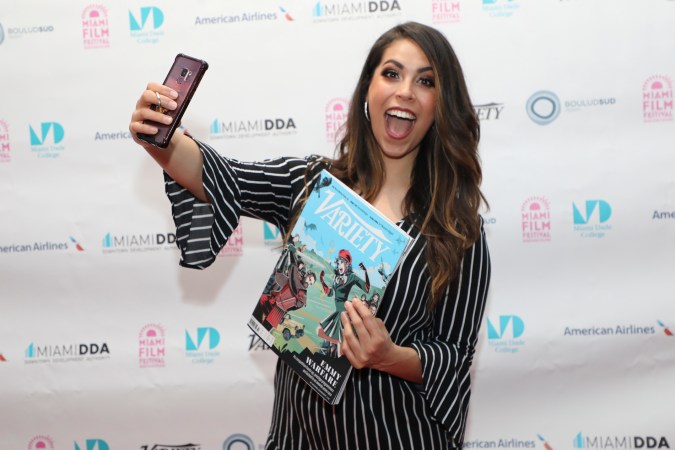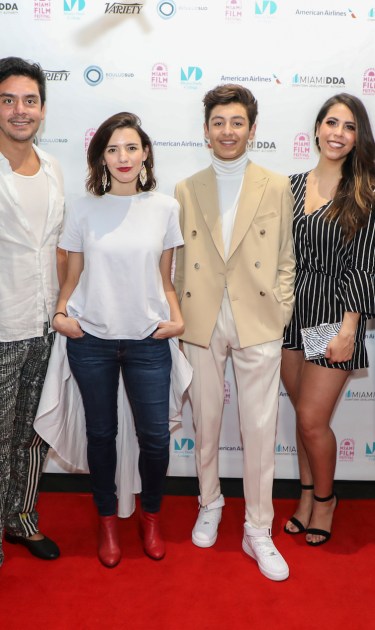If there was one theme running through the panel conversation celebrating Variety‘s 10 Latinx to Watch, it was the desire to keep breaking stereotypes. Taking place during the Miami Film Festival, the event featured five of this year’s honorees: directors Lila Avilés (The Chambermaid), Jayro Bustamante (Ixcanul, Tremors), and Gigi Saul Guerrero (La Quinceañera), as well as actors Daniel Zovatto (Don’t Breathe) and Marcel Ruiz (One Day at a Time). Representing five different countries, these five young Latinx and Latin Americans made it clear why we should all be paying attention to their work.
Avilés and Bustamante, both of whom were showing their films at the fest, talked about the challenges of producing their work in Mexico and Guatemala respectively. For Avilés, who came from a theater background, breaking into film was an uphill battle. That’s why she opted to produce her own debut, shooting it in just 17 days and later earning the requisite production grants to finish it. An exploration of a chambermaid in a luxurious Mexico City hotel, Avilés calls her film “a kind of poem to Mexico,” one which doesn’t shy away from delving into the darker parts of her home country.
For Bustamante, whose movie Ixcanul marked a watershed moment for the minuscule Guatemalan film industry, making films doubles as a way to nurture the budding film industry in the Central American nation. He’s intent on creating more infrastructure for other filmmakers in his home country to succeed. Much like Avilés’ work, Bustamante’s latest film Tremors offers a probing examination of social and cultural issues. The gay conversion drama takes on what Bustamante dubs one of Guatemala’s most common and insidious insults: hueco (literally “empty” but slang for fag). He shared that he drew inspiration from 1970s films: both US features and Japanese documentaries, all the while singling out the work of Lucrecia Martel (whom Avilés called a “goddess of cinema”) in helping him figure out how to create the effect of an earthquake solely through sound.
But even in the United States, where there’s a thriving film industry, there remain barriers to be broken. Mexican-Canadian Guerrero, for example, talked about being a Latina horror director. “I like to look at it not as a disadvantage but as an advantage to stand out.” Her pitch to Blumhouse pictures, which will be releasing her upcoming Richard Cabral-starring film as an installment of Hulu’s Into the Dark anthology series, centered on what she brought to the project as a Latina. “If you guys hire me,” she told them on her fourth pitch for the show, “I’m gonna make this so Mexican, so chingona! There will be sangre, I promise! Let me make this as Mexican as possible.” She won out, and she’s proud that she got the project to be fully bilingual. The timely and gory horror film, which comes out on the fourth of July, will deal with what Independence Day means to Mexican immigrants in the US.

For those working in front of the camera, similar conversations about what being Latinx means to executives and audiences is an ongoing struggle. Zovatto, who hails from Costa Rica and now lives in Los Angeles, has been told time and time again that he doesn’t look ‘Latino enough.’ “It’s the opposite of what happens to my Latino friends,” he shared, “where they’re too Latino. It was really confusing to me because we’re all different colors and shades and sizes. And we’re all Latino! It’s a big culture. It’s a big community of people. I feel like in the States people had a misconception of what that was.” It wasn’t until he was cast in Vandal, the Miami-set street art drama that played the festival this year, that he finally got to play a Latino character. The actor, who’ll soon be seen in the Mexican-American themed season of Penny Dreadful: City of Angels, credited Diego Luna, Gael García Bernal, as well as Mexican directors like Iñárritu and Cuarón, with slowly moving the needle forward when it came to Latinx representation in Hollywood.
As the youngest of those assembled, Ruiz spoke about the misconceptions he had to deal with when he and his family moved from Puerto Rico to LA. He had schoolmates who earnestly asked him how long it took to drive to PR, thinking it was somewhere in Mexico. And, just as his character Alex on One Day at a Time, he had his fair share of racial slurs lobbed his way. It’s what makes him relate to his character so much. “What he goes through in school, how he’s always looking at his hair, and super obsessive with his clothes: that’s pretty much what I do!” While his next role is in the faith-based drama Breakthrough, Ruiz has his sights set on designing his own clothing line, citing current Louis Vuitton menswear designer Virgil Abloh as an inspiration and a role model.

In addition to these five honorees, Variety also cited Isabela Moner (Dora the Explorer), Rosa Salazar (Alita: Battle Angel, Bird Box), Lali Esposito (The Accused), Augusto Aguilera (The Predator) as well as YouTube star Whindersson Nunes (Party Crashers 2) in this year’s announcement. As moderator Malina Saval, features editor of Variety, explained while introducing the attendees, winnowing down 2019’s list just to ten was a difficult task. There’s a bountiful talented pool from which to choose. But together these ten names showcase the vibrant and diverse work being produced by and for the Latino and Latin American communities.





